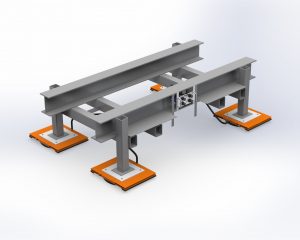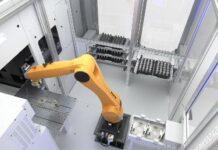One of the major problems manufacturers face with tooling and machinery is the difficulty of moving heavy equipment from point to point. For example, a machine left on the manufacturing floor might become an obstacle, potentially causing an accident or injury.
What happens when the manufacturer changes to a reconfigurable system in which machines in a production line need to be swapped or moved elsewhere to meet changing production demands? Regardless of the situation, finding an effective way to mobilize heavy machinery is critical for end-users and a design challenge for original equipment manufacturers (OEMs). Fortunately, it’s a challenge they can solve. The solution: design machines that float by using an embedded air bearing system as built-in rigging.
The Technology of Air Casters
Air bearings, also known as air casters, function on the same principles as a puck on an air hockey table, where the puck literally floats on a membrane of air. Just like the puck, an air membrane can easily lift and float thousands of pounds of machinery. An operator attaches an air hose to the air bearing unit (load module), and the machine or tooling is lifted on a business card-thin layer of air. Thanks to a friction coefficient of less than two percent, a single operator exerting no more than five to 25 pounds of force can move machinery as heavy as 5,000-10,000 pounds. Heavier machines may require more people, but they can be moved just as easily because the same principles apply.
Designers working on hard-to-move machines can incorporate this easy-to-use mobility technology to eliminate operational disruption for end-users and vastly reduce the costs associated with traditional methods of machinery relocation. For OEMs, this presents an opportunity to competitively differentiate themselves and potentially upsell their offering by adding significant value for the end-user at the marginal cost of a simple add-on feature.
Air Bearing Systems Versus Other Options
 Traditional mobility solutions may not always work. Installing wheeled casters, for example, maybe impractical. Wheels can have weight limitations, and they also may damage factory floors that cannot withstand the pressure they exert given their small floor contact area. Further, the sheer amount of force they require to move very heavy machinery may exceed practical or safe limits.
Traditional mobility solutions may not always work. Installing wheeled casters, for example, maybe impractical. Wheels can have weight limitations, and they also may damage factory floors that cannot withstand the pressure they exert given their small floor contact area. Further, the sheer amount of force they require to move very heavy machinery may exceed practical or safe limits.
Setting equipment on platforms for forklifts to move is another option, but that too has its drawbacks. Fork trucks can be as unwieldy as the loads they lift, even if driven by experienced, certified operators. In many plant environments, inches matter, and fork vehicles may not have sufficient room to maneuver. Operators may have to shut down production and move other equipment just to assure the right amount of access for the truck. Similarly, the setup time required of the material handling system can affect its feasibility, as an Illinois-based machinery manufacturer noted when evaluating air casters, “It was difficult to move cabinets by overhead crane in a shorter time, as setup time was higher. Therefore, to improve the movement time, we decided to use air casters.”
There are additional benefits as well. Air bearing systems readily fit inside any existing equipment footprint without the need for additional floor space. Operations require neither special equipment nor certified operators, which reduces the possibility of unwanted downtime, delays, and disruption.
Embedded air casters compound these advantages. Since they’re already built-in, all an operator needs to do is attach the air hose, push the load into position and deflate—all of which can be accomplished in minutes.
Facts Machine Designers Need to Know
Approach is everything in optimizing an embedded air bearing system. Air casters are not necessarily one-size-fits-all. First, designers will need access to engineering models to ensure proper fit and function or identify any appropriate adjustments to make. Access to complete engineering models enables designers to evaluate the air caster option without expending much in the way of time or resources. Second, during evaluation, designers should be able to answer a series of questions:
- How much will the machinery weigh?
This question may seem a little misleading. Air casters can work with virtually any weight; that’s not the issue. Weight, however, will impact structure support, specifically the number of support points that will have to be placed beneath the object. In most cases, OEM designers should expect to use four to six air casters.
- What load can the floor take? While air casters tend to outperform other mobility methods in preserving floors from damage or even simple wear-and-tear, they can still exert pressure. Surface quality and condition of the floor should be considered as should the number and size of air casters required. The size determines how widely the weight of the load will be distributed.
- What air supply is available? After determining the number and size of air casters to support the given load at its intended destination environment, the machine designer can figure out the amount of air pressure per caster. In most cases, ordinary shop air should be sufficient, but equipment designers should verify the appropriate air pressure. The amount of airflow will also impact the type of control panel for equipment operators to incorporate into the design.
- How do you want to attach the air casters? The answer to this question is largely at the discretion of the designer. The cost to install is typically low because designers can determine which type of attachment such as bolts, screws, welding or other means works best. Here again, access to engineering models makes all the difference. Pre-built mounting points facilitate designer decision-making on either positioning the air casters or engineering a new hole pattern that will adapt existing equipment and integrate the air bearing system.
A Flexible Response To Changing Demands
Manufacturing today requires flexibility—the ability to change on the fly. To stay ahead of the curve and maintain profitability, manufacturers need to keep up without incurring added costs or productivity losses. Admittedly this is a challenge, but it is certainly solvable. OEM designers can generate previously untapped value for their customers and themselves by designing and building flexible machines capable of repositioning, relocating and reconfiguring as soon as needed. A thin layer of air produced by embedded air casters makes all of these possible, enhancing a facility’s mobility, safety, and productivity while reducing system costs.



















